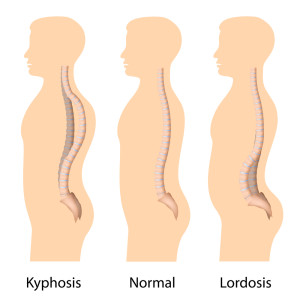Hyperlordosis is defined as an excessive curvature in either the lumbar or cervical areas of the spinal column. These two regions of the spinal column are noted for having a natural curve but sometimes these curves become exaggerated, most often in the lumbar region. Hyperlordosis is also known as “swayback” when it occurs in the lumbar area of the spine.
Hyperlordosis is generally caused by either of two conditions. The first cause is muscular in nature. The muscles surrounding the affected area cause the bones to be pulled out of alignment to a degree that the normal curvature becomes exaggerated. The other cause of hyperlordosis is actual structural changes to the discs or bones of the spine.

What Causes Hyperlordosis?
- Poor Posture
- Obesity
- Osteoporosis (weakening of the bones with age)
- Discitis (a disorder of the disks between the spinal vertebrae)
- Kyphosis (an excessive outward curvature at the upper-back)
- Spondylolisthesis
Many people have hyperlordosis due to weak abdominal muscles and obesity, where the excess fat is found residing mainly in the abdominal and buttocks area.
A sedentary lifestyle is also a significant factor, particularly for those who spend an excessive amount of time sitting, such as truck or bus drivers and office workers.
Both the excess weight and the poor muscle tone from lack of exercise, cause the muscles in the lumbar area to tighten excessively for prolonged periods of time. This is in an attempt to provide support and stabilization to the spinal column. The muscles gradually pull the spine out of normal alignment, resulting in an excessive curve.
Less common, hyperlordosis can be caused by structural issues of the spine. Some conditions that can aggravate the structure of the spinal column are osteoporosis, a disease which causes bones to weaken and a condition called spondylolisthesis. Spondylolisthesis is a condition where spinal vertebrae move out of their normal position. A misaligned vertebra can damage adjacent discs and/or impair normal nerve function.
When to See a Medical Professional:
- Muscle spasms
- Tingling or numbness
- Bladder or bowel difficulties
- A fixed curve in the lower back (stays in place even when bending forward)
If you see a doctor for your low back pain they may initially prescribe drugs to relieve any pain and inflammation but a long-term treatment plan will be needed to reverse or at least prevent further curvature.
The treatment will most likely include a weight loss plan and physical therapy exercises designed to stretch and strengthen abdominal, hip and buttock regions and improve posture. Learn tips on how to lose weight to reduce back pain in our weight loss blog.
While working on weight loss and exercise goals, those suffering from lumbar hyperlordosis, may also find some temporary relief by sleeping on their back with pillows underneath their knees. This will allow their lumbar muscles to get some much-needed time to relax.
For the average person, preventative care is the best way to avoid encountering spinal issues. Maintaining flexibility and muscular strength is particularly important for those with sedentary jobs.
For more information on how to keep your spine strong and healthy for a lifetime, please contact us.
